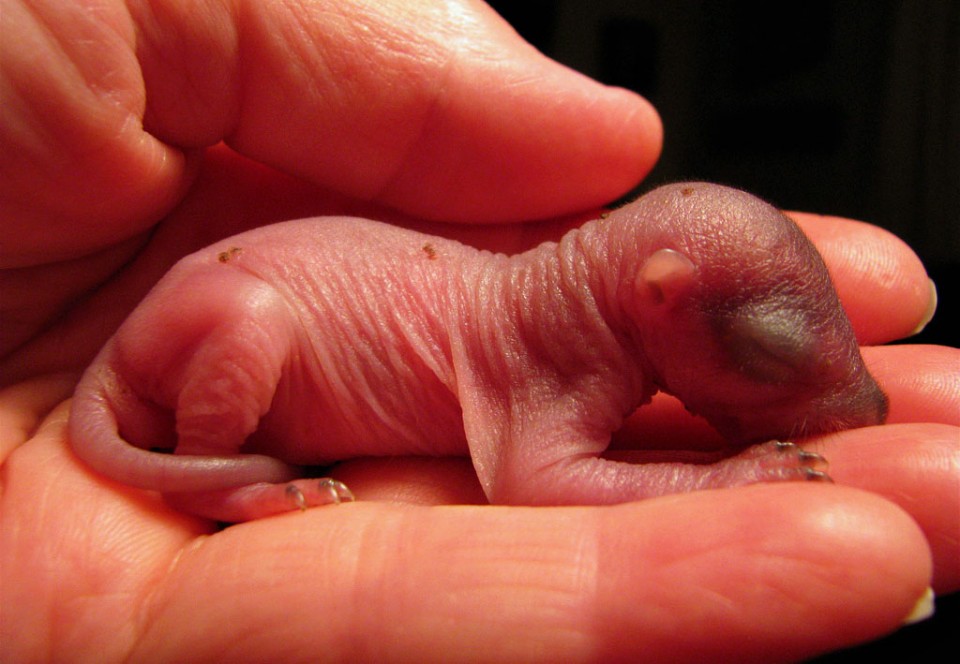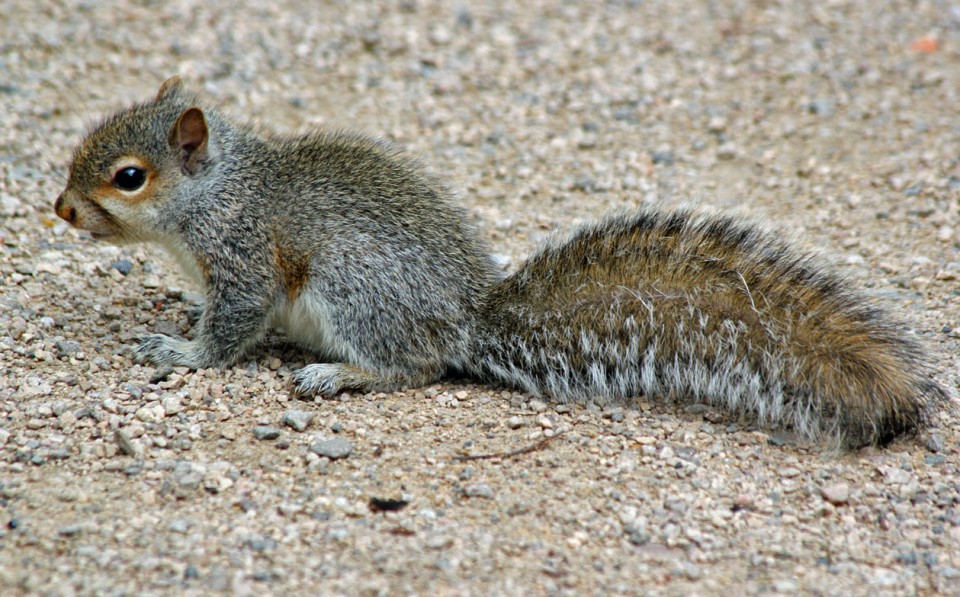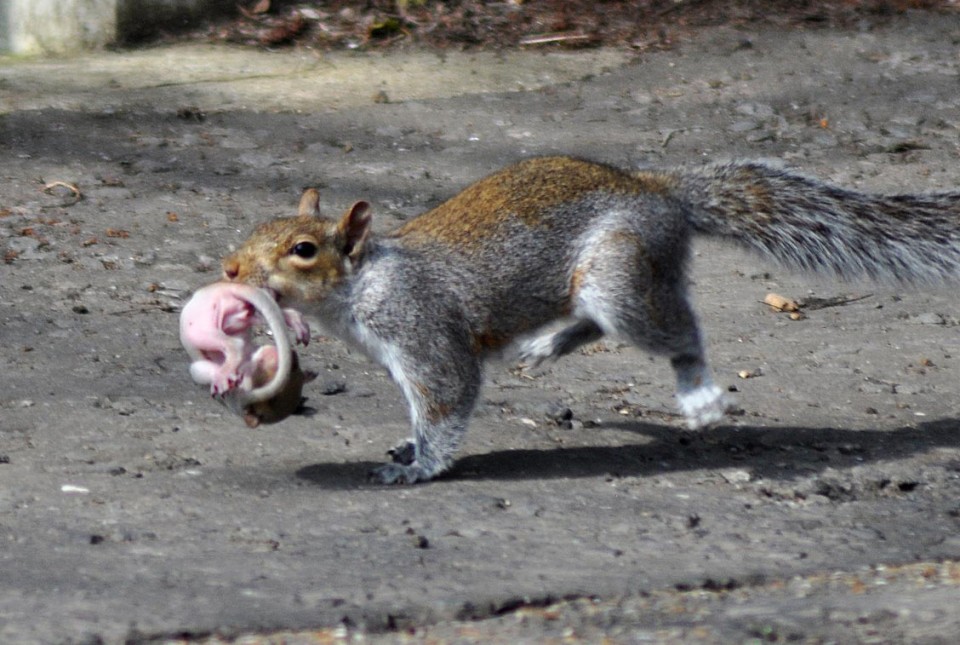Squirrel Breeding Biology - Gestation, Birth & Kitten Development
Female squirrels are polyoestrous, that is they have multiple ovulation cycles each year, and are receptive for only one day during each cycle. Broadly-speaking, the breeding season runs from late December to late August but, as discussed above, this is heavily dependent on weather and food availability. Nonetheless, this translates to young being born as early as mid-February and as late as mid-November. Kittens are born in sturdy a natal drey that is built by the female. Males play no part in raising the young.

Natal dreys are often difficult for researchers to reach and their construction makes it difficult to inspect their contents without causing damage. Consequently, it is very difficult to collect data on litter size and kitten mortality and much of the following information is based on data from captive animals. Red squirrels produce a litter of, on average, four young (called kittens), following a gestation of between 36 and 42 days -- litters of up to seven have been reported.
The kittens are generally between 10g and 18g (half an oz.) at birth, with heavier mothers giving birth to heavier kittens, and the mother will suckle them for 50 to 70 days. Greys typically produce between two and four kittens (eight being the maximum) after at 42 to 45 day gestation -- as with Reds, the kittens weigh 14-18g at birth and the female will lactate for about 70 days. I'm not aware of any chemical analyses of Red squirrel milk, but, according to a study by Charles Nixon and Jim Harper on squirrel in Ohio, Grey milk is high in fat (12-25%) and protein (10%), with 3-4% lactose, allowing a rapid growth of the kittens. Wildlife rehabilitators have reported difficulty raising kittens on cow's milk, although according to John Paling, cat milk is a suitable substitute and he was able to get a cat to surrogate a squirrel among its own litter.
Squirrels produce altricial young, which means the kittens are blind, deaf and naked at birth. Skin pigment develops and the first hairs appear on the back after about 14 days, with fur growth complete by about three weeks. The first teeth, the lower incisors, erupt at about three weeks old and the eyes and ears open about a week later. While in the drey, the young will chew twigs to 'cut' their teeth and the upper incisors are cut as much as three weeks later than the lower. Females of both species exhibit parental care and are very protective of their young, aggressively defending the drey and readily chasing away any intruders.

Females are highly protective of their young, and will defend them from predators and move them to an alternative drey if disturbed. Kittens are typically carried in the mother's mouth but, in The Inner Life of Animals, Peter Wohlleben described how a Red squirrel in his garden in Eifel, Germany periodically collapsed while moving through his garden with what he initially considered an ominous lump on its neck:
"The lump turned out to be a baby wrapped around its mother's neck like a furry ruff. The baby's stranglehold, along with the shimmering heat, meant the squirrel mother could only suck in enough air to take a few steps before falling over sideways, exhausted and gasping for breath."
Kittens themselves can be aggressive at a very early age (even before their eyes have opened) if disturbed or distressed in the nest. In Squirrel on my Shoulder, John Paling described how his kitten "Sammy" would open his mouth to display his teeth when distressed by competition over a nipple while suckling or being dried by Paling after a bath. Interestingly, Paling noted how, despite only the lower incisors having erupted by this stage, the illusion of upper incisors was given by a simple patterning on the upper lip. Paling wrote:
"There are two pale areas of skin below the nose which divide down to the upper jaw and closely resemble a pair of upper teeth. It may be significant that in adult squirrels this patterning disappears. It seems possible that baby squirrels have these mimic teeth to add to their threat potential when they are still suckling ..."

The young squirrels start venturing out of the drey at six to seven weeks old, at which point they also begin taking solid food. By 10-12 weeks old the kittens have their first full set of (milk) teeth and are fully weaned. In Grey squirrels, maternal care appears to end once the kittens are weaned, while Red mothers may continue to defend them for up to two weeks post-weaning. As the nursing period progresses, the female will begin spending more and more time away from her offspring so that, at the time of weaning, she may move back to her old dreys, leaving the young together in the breeding drey to fend for themselves. The kittens will moult into their adult coat at around four months old and the milk teeth are lost at between four and eight months old, replaced by the permanent teeth.
Red squirrels reach sexually maturity are between nine and 11 months old and, although some American females have been found sexually receptive at six months old, most Greys will not breed until they're a year old. Fecundity (i.e., number of kittens born) and breeding success (number of successfully weaned kittens) are highly dependent on habitat quality and resource availability -- seemingly more so in deciduous woodlands than in conifer forests. Furthermore, it seems that reproductive rate is inversely related to female abundance, so as the number of females in an area increases, the number of females breeding decreases. There are examples of adoption of abandoned/orphaned kittens in North American red squirrels (Tamiasciurus hudsonicus), Jamieson Gorrell and colleagues describing five such occurrences in the 2,230 litters they observed during their 19-year Yukon study in a 2010 paper to Nature Communications, although I know of no equivalent records in S. carolinensis or S. vulgaris.